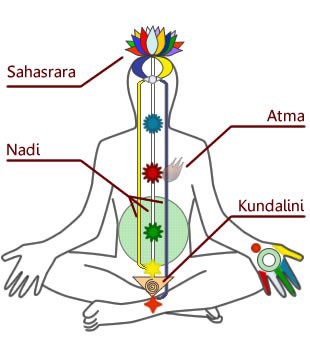Nadi Shodhana Breathing Calms the Nerves
What is Nadi Shadhana? The word Nadi is Sanskrit for “channel.” It also means “purification” and when utilized, it is known to balance the human system. Done in private, it has a profound impact on the mind, body, and spirit. Indeed, every 90 minutes we naturally switch which nostril is dominant. The dominant nostril provides more stimulation to the brain and nervous system. Promoting balance through the body’s midline, Nadi Shadhana balances the parasympathetic and sympathetic nervous systems as well as stimulating the vagus nerve.
Nadi Shodhana Breathing Through Alternate Nostril
Also known as alternate nostril breathing, Nadi Shodhana is a relaxation technique that helps to calm the nervous system. This breathing is most effective when done properly, such as with Yoga & Meditation. First, sit comfortably. Preferably in a cross-legged position. Take the first two fingers of the right hand to the third eye . . . Ajna chakra. Open and close the right nostril with the right thumb and left nostril with the right ring finger. As you inhale deeply through the left nostril, close off the right nostril with your right thumb. Count to yourself; one om, two om, three om, etc. As high as possible, with no tension.
Try starting with a count of four or five. After closing the left nostril with the right ring finger, exhale out the right by releasing the thumb. Do this one count longer than the inhale. So, if you inhale a count of four, you exhale a count of five. Follow this way . . . inhaling through the left, exhaling out the right, then inhaling through the right and exhaling out the left for a few minutes. Ultimately, 3-5 minutes is a good starting point, then 5-10 minutes is a great effort.
Benefits of Nadi Shodhana Breathing
In fact, one study found that practicing Nadi Shadhana 30 minutes a day for four weeks reduced diastolic blood pressure, pulse rate, and respiratory rate thus sending the body into a relaxed state. Alternative breathing is known to reduce anxiety and bring relaxation to the entire body. It helps lower blood pressure and helps maintain body temperature. Moreover, it balances the right and left hemispheres of the brain and provides more blood supply. It improves focus and concentration. This is important to maintaining our logical and creative thoughts. Most importantly, it helps bring us into the present moment, thus escaping thought altogether.
This practice also removes carbon dioxide and other waste products from the body. Opening the energy channels (Nadis) removes blockages and opens the free flow of energy in the system. Indeed it even impacts our metabolism by providing oxygen to the blood and every cell in the body.
Balancing Your Masculine and Feminine
This yogic form of breathing/pranayama helps balance the masculine and feminine within oneself. It creates a free flow of energy up and down Ida and Pingala nadis, the two primary energy lines (pingala=masculine and ida=feminine) up and down the body. It is said that once these two energy channels are completely flowing, unobstructed, the primary Nadi Sushumna flows smoothly. Sushumna runs up and down the spine. When it is perfectly open, one can reach Enlightenment. Even if Enlightenment is out of reach or not desired, Nadi Shodhana helps to create a perfectly calm relaxed nervous system state, something we can all benefit from.

In Nadi Shodhana Pranayama, alternate-nostril breathing is used to purify the subtle body’s energy channels. Shodhana means “to purify.” SpiritQuest Sedona Retreats offers Yoga and Meditation Retreats, teaching you how to restore this calm balance through Nadi Shadhana. If you slow your breathing down (through meditation for example) you balance your chakras and process personal hurts. Which in turn allows you to effectively maintain your perspective. When practicing Yoga and Meditation, you may encounter uncomfortable negative emotions through your breathing. In fact, you train your subconscious mind to scan for miracles instead of threats by changing its perception and programming through chakra balancing in Sedona


